Leadership Report: Diageo's Organisational Performance and Culture
VerifiedAdded on 2023/01/05
|10
|2802
|46
Report
AI Summary
This report provides a comprehensive analysis of leadership's influence on organisational performance and business practices, using Diageo as a case study. It explores the impact of leadership on productivity, employee morale, and customer satisfaction, examining various leadership models such as contingency theory and Fiedler's model. The report delves into motivational theories, including Vroom's expectancy theory, Adam's equity theory, and Locke's goal-setting theory, and their application within the organisation. Furthermore, the report investigates the impact of leadership on organisational culture, diversity management, and the importance of adapting to changing environments. The report emphasizes the importance of leadership in shaping organisational functions, performance, and overall success, highlighting the interplay between leadership styles, employee engagement, and business outcomes within the context of a global beverage company.
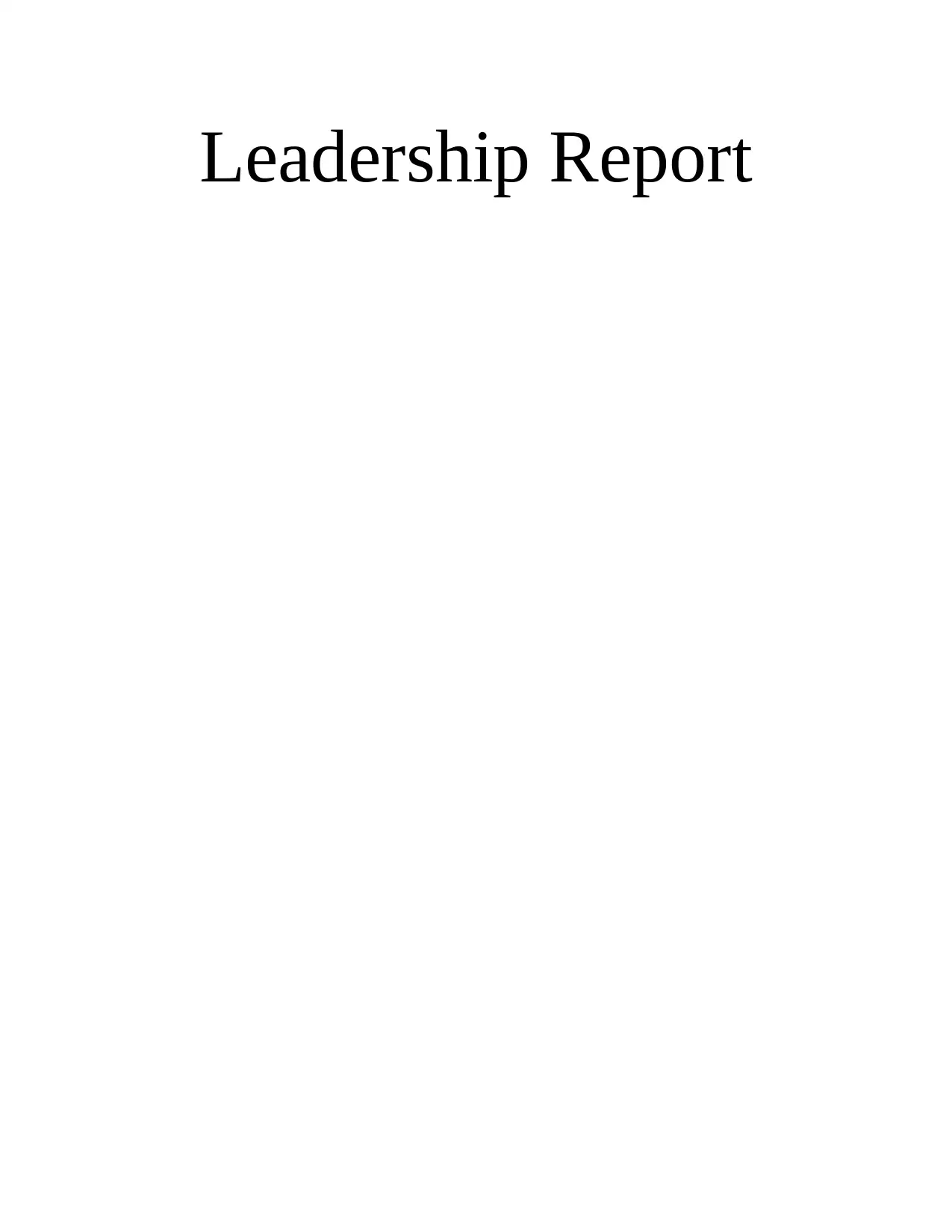
Leadership Report
Paraphrase This Document
Need a fresh take? Get an instant paraphrase of this document with our AI Paraphraser
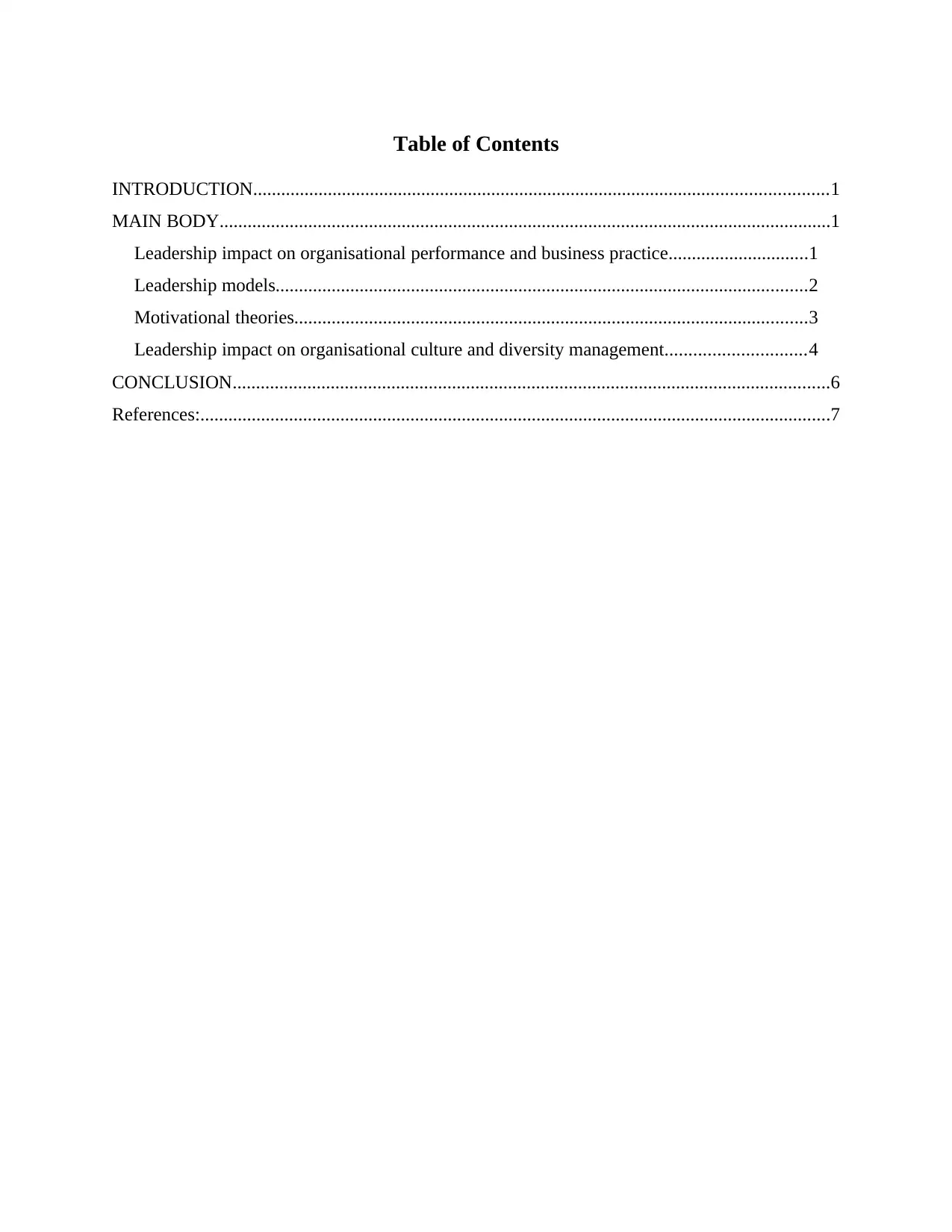
Table of Contents
INTRODUCTION...........................................................................................................................1
MAIN BODY...................................................................................................................................1
Leadership impact on organisational performance and business practice..............................1
Leadership models..................................................................................................................2
Motivational theories..............................................................................................................3
Leadership impact on organisational culture and diversity management..............................4
CONCLUSION................................................................................................................................6
References:.......................................................................................................................................7
INTRODUCTION...........................................................................................................................1
MAIN BODY...................................................................................................................................1
Leadership impact on organisational performance and business practice..............................1
Leadership models..................................................................................................................2
Motivational theories..............................................................................................................3
Leadership impact on organisational culture and diversity management..............................4
CONCLUSION................................................................................................................................6
References:.......................................................................................................................................7
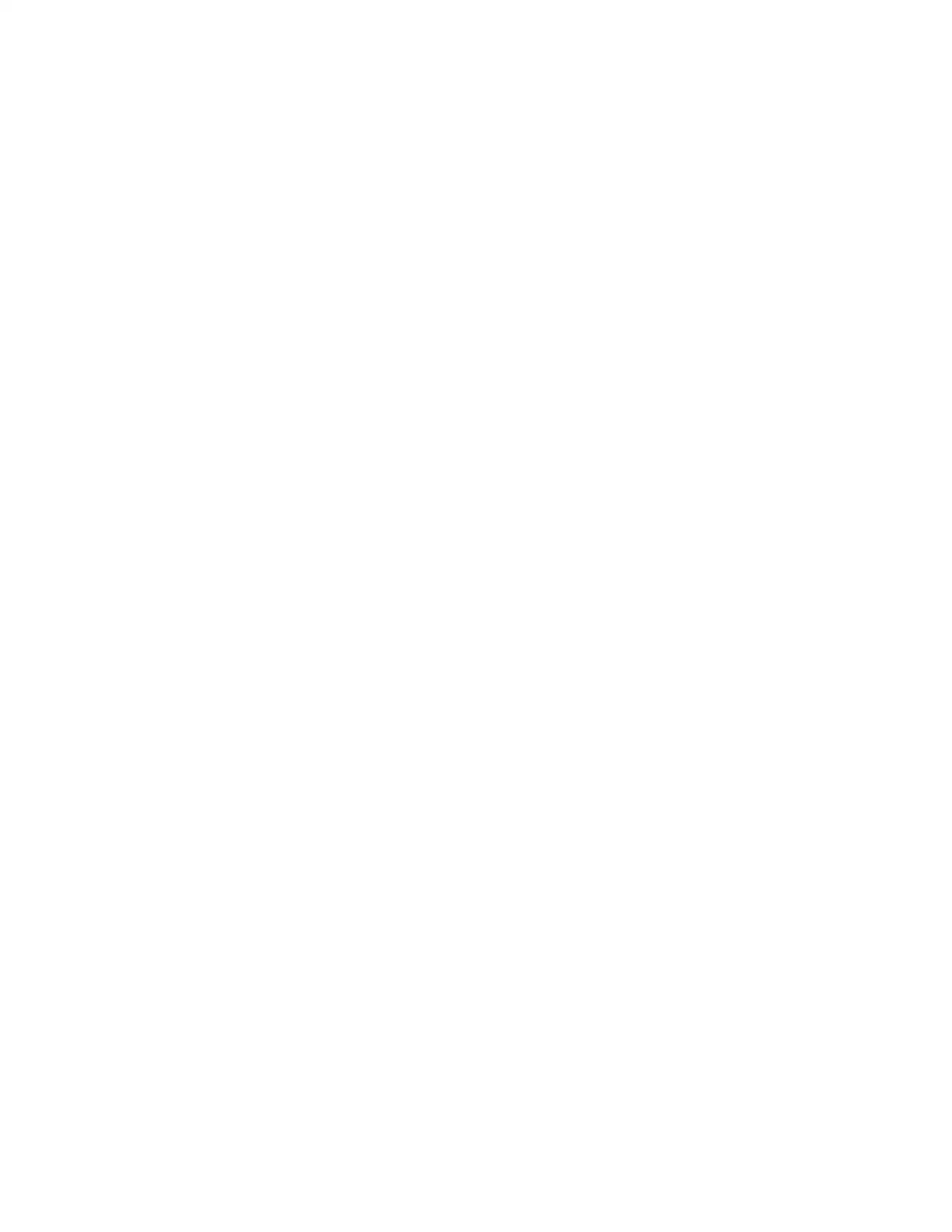
⊘ This is a preview!⊘
Do you want full access?
Subscribe today to unlock all pages.

Trusted by 1+ million students worldwide
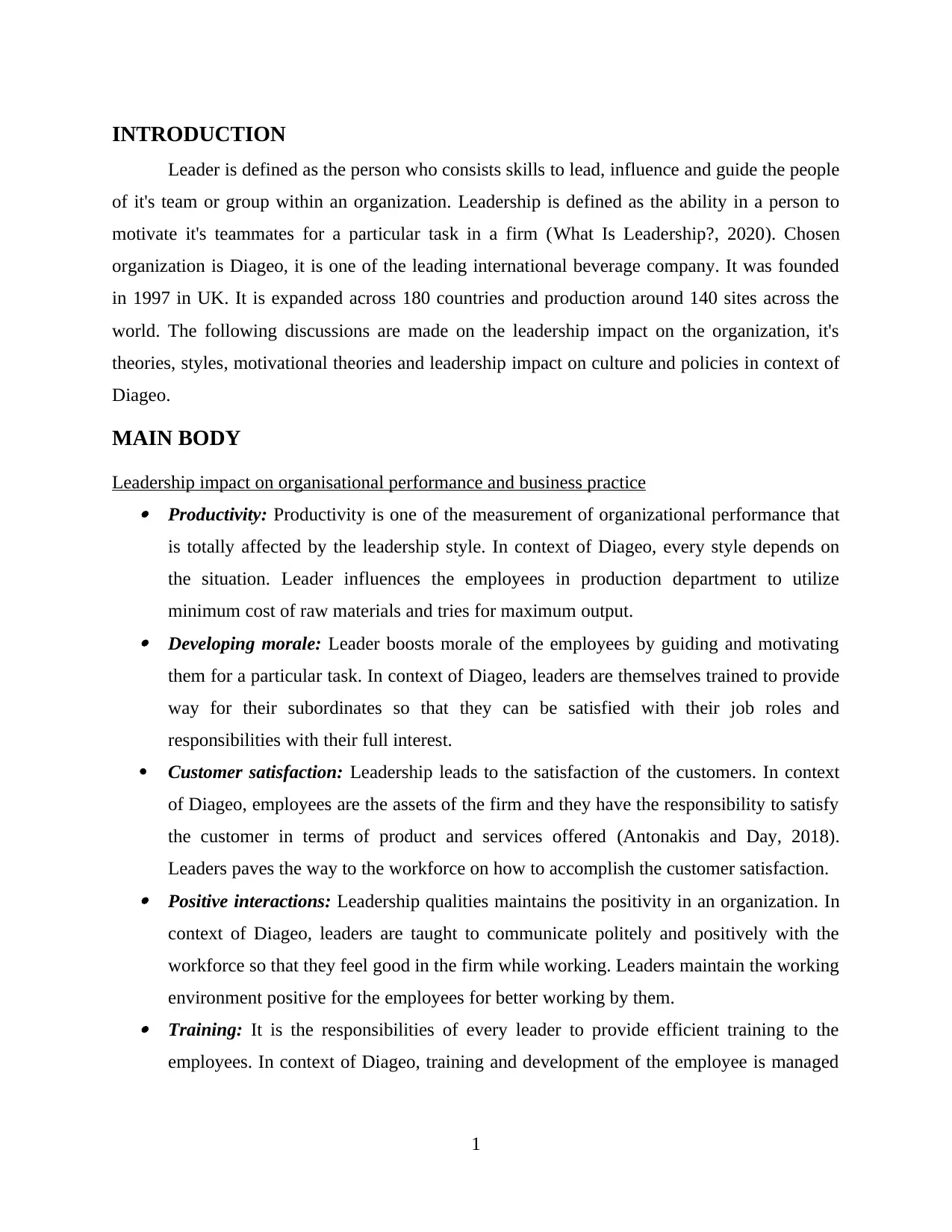
INTRODUCTION
Leader is defined as the person who consists skills to lead, influence and guide the people
of it's team or group within an organization. Leadership is defined as the ability in a person to
motivate it's teammates for a particular task in a firm (What Is Leadership?, 2020). Chosen
organization is Diageo, it is one of the leading international beverage company. It was founded
in 1997 in UK. It is expanded across 180 countries and production around 140 sites across the
world. The following discussions are made on the leadership impact on the organization, it's
theories, styles, motivational theories and leadership impact on culture and policies in context of
Diageo.
MAIN BODY
Leadership impact on organisational performance and business practice Productivity: Productivity is one of the measurement of organizational performance that
is totally affected by the leadership style. In context of Diageo, every style depends on
the situation. Leader influences the employees in production department to utilize
minimum cost of raw materials and tries for maximum output. Developing morale: Leader boosts morale of the employees by guiding and motivating
them for a particular task. In context of Diageo, leaders are themselves trained to provide
way for their subordinates so that they can be satisfied with their job roles and
responsibilities with their full interest.
Customer satisfaction: Leadership leads to the satisfaction of the customers. In context
of Diageo, employees are the assets of the firm and they have the responsibility to satisfy
the customer in terms of product and services offered (Antonakis and Day, 2018).
Leaders paves the way to the workforce on how to accomplish the customer satisfaction. Positive interactions: Leadership qualities maintains the positivity in an organization. In
context of Diageo, leaders are taught to communicate politely and positively with the
workforce so that they feel good in the firm while working. Leaders maintain the working
environment positive for the employees for better working by them. Training: It is the responsibilities of every leader to provide efficient training to the
employees. In context of Diageo, training and development of the employee is managed
1
Leader is defined as the person who consists skills to lead, influence and guide the people
of it's team or group within an organization. Leadership is defined as the ability in a person to
motivate it's teammates for a particular task in a firm (What Is Leadership?, 2020). Chosen
organization is Diageo, it is one of the leading international beverage company. It was founded
in 1997 in UK. It is expanded across 180 countries and production around 140 sites across the
world. The following discussions are made on the leadership impact on the organization, it's
theories, styles, motivational theories and leadership impact on culture and policies in context of
Diageo.
MAIN BODY
Leadership impact on organisational performance and business practice Productivity: Productivity is one of the measurement of organizational performance that
is totally affected by the leadership style. In context of Diageo, every style depends on
the situation. Leader influences the employees in production department to utilize
minimum cost of raw materials and tries for maximum output. Developing morale: Leader boosts morale of the employees by guiding and motivating
them for a particular task. In context of Diageo, leaders are themselves trained to provide
way for their subordinates so that they can be satisfied with their job roles and
responsibilities with their full interest.
Customer satisfaction: Leadership leads to the satisfaction of the customers. In context
of Diageo, employees are the assets of the firm and they have the responsibility to satisfy
the customer in terms of product and services offered (Antonakis and Day, 2018).
Leaders paves the way to the workforce on how to accomplish the customer satisfaction. Positive interactions: Leadership qualities maintains the positivity in an organization. In
context of Diageo, leaders are taught to communicate politely and positively with the
workforce so that they feel good in the firm while working. Leaders maintain the working
environment positive for the employees for better working by them. Training: It is the responsibilities of every leader to provide efficient training to the
employees. In context of Diageo, training and development of the employee is managed
1
Paraphrase This Document
Need a fresh take? Get an instant paraphrase of this document with our AI Paraphraser
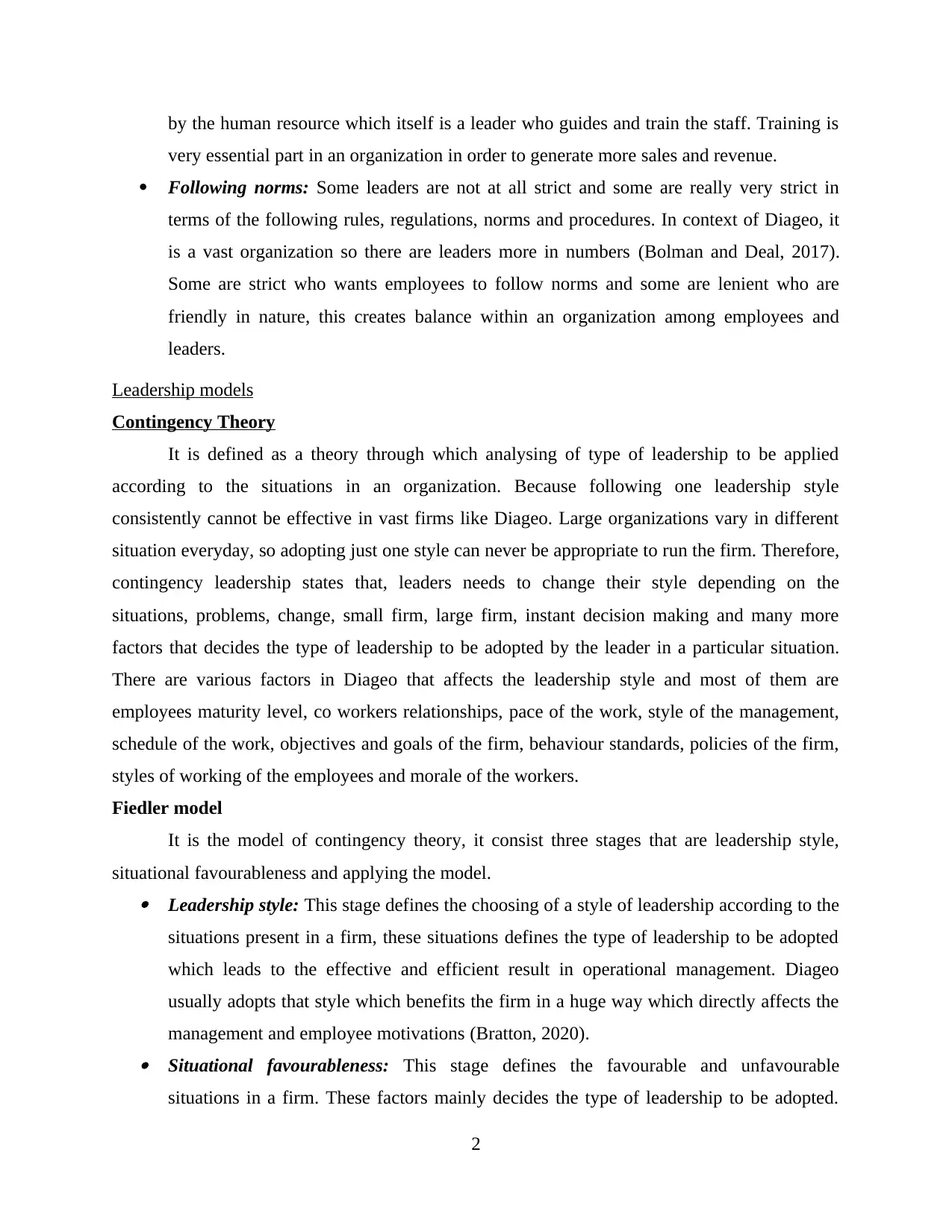
by the human resource which itself is a leader who guides and train the staff. Training is
very essential part in an organization in order to generate more sales and revenue.
Following norms: Some leaders are not at all strict and some are really very strict in
terms of the following rules, regulations, norms and procedures. In context of Diageo, it
is a vast organization so there are leaders more in numbers (Bolman and Deal, 2017).
Some are strict who wants employees to follow norms and some are lenient who are
friendly in nature, this creates balance within an organization among employees and
leaders.
Leadership models
Contingency Theory
It is defined as a theory through which analysing of type of leadership to be applied
according to the situations in an organization. Because following one leadership style
consistently cannot be effective in vast firms like Diageo. Large organizations vary in different
situation everyday, so adopting just one style can never be appropriate to run the firm. Therefore,
contingency leadership states that, leaders needs to change their style depending on the
situations, problems, change, small firm, large firm, instant decision making and many more
factors that decides the type of leadership to be adopted by the leader in a particular situation.
There are various factors in Diageo that affects the leadership style and most of them are
employees maturity level, co workers relationships, pace of the work, style of the management,
schedule of the work, objectives and goals of the firm, behaviour standards, policies of the firm,
styles of working of the employees and morale of the workers.
Fiedler model
It is the model of contingency theory, it consist three stages that are leadership style,
situational favourableness and applying the model. Leadership style: This stage defines the choosing of a style of leadership according to the
situations present in a firm, these situations defines the type of leadership to be adopted
which leads to the effective and efficient result in operational management. Diageo
usually adopts that style which benefits the firm in a huge way which directly affects the
management and employee motivations (Bratton, 2020). Situational favourableness: This stage defines the favourable and unfavourable
situations in a firm. These factors mainly decides the type of leadership to be adopted.
2
very essential part in an organization in order to generate more sales and revenue.
Following norms: Some leaders are not at all strict and some are really very strict in
terms of the following rules, regulations, norms and procedures. In context of Diageo, it
is a vast organization so there are leaders more in numbers (Bolman and Deal, 2017).
Some are strict who wants employees to follow norms and some are lenient who are
friendly in nature, this creates balance within an organization among employees and
leaders.
Leadership models
Contingency Theory
It is defined as a theory through which analysing of type of leadership to be applied
according to the situations in an organization. Because following one leadership style
consistently cannot be effective in vast firms like Diageo. Large organizations vary in different
situation everyday, so adopting just one style can never be appropriate to run the firm. Therefore,
contingency leadership states that, leaders needs to change their style depending on the
situations, problems, change, small firm, large firm, instant decision making and many more
factors that decides the type of leadership to be adopted by the leader in a particular situation.
There are various factors in Diageo that affects the leadership style and most of them are
employees maturity level, co workers relationships, pace of the work, style of the management,
schedule of the work, objectives and goals of the firm, behaviour standards, policies of the firm,
styles of working of the employees and morale of the workers.
Fiedler model
It is the model of contingency theory, it consist three stages that are leadership style,
situational favourableness and applying the model. Leadership style: This stage defines the choosing of a style of leadership according to the
situations present in a firm, these situations defines the type of leadership to be adopted
which leads to the effective and efficient result in operational management. Diageo
usually adopts that style which benefits the firm in a huge way which directly affects the
management and employee motivations (Bratton, 2020). Situational favourableness: This stage defines the favourable and unfavourable
situations in a firm. These factors mainly decides the type of leadership to be adopted.
2
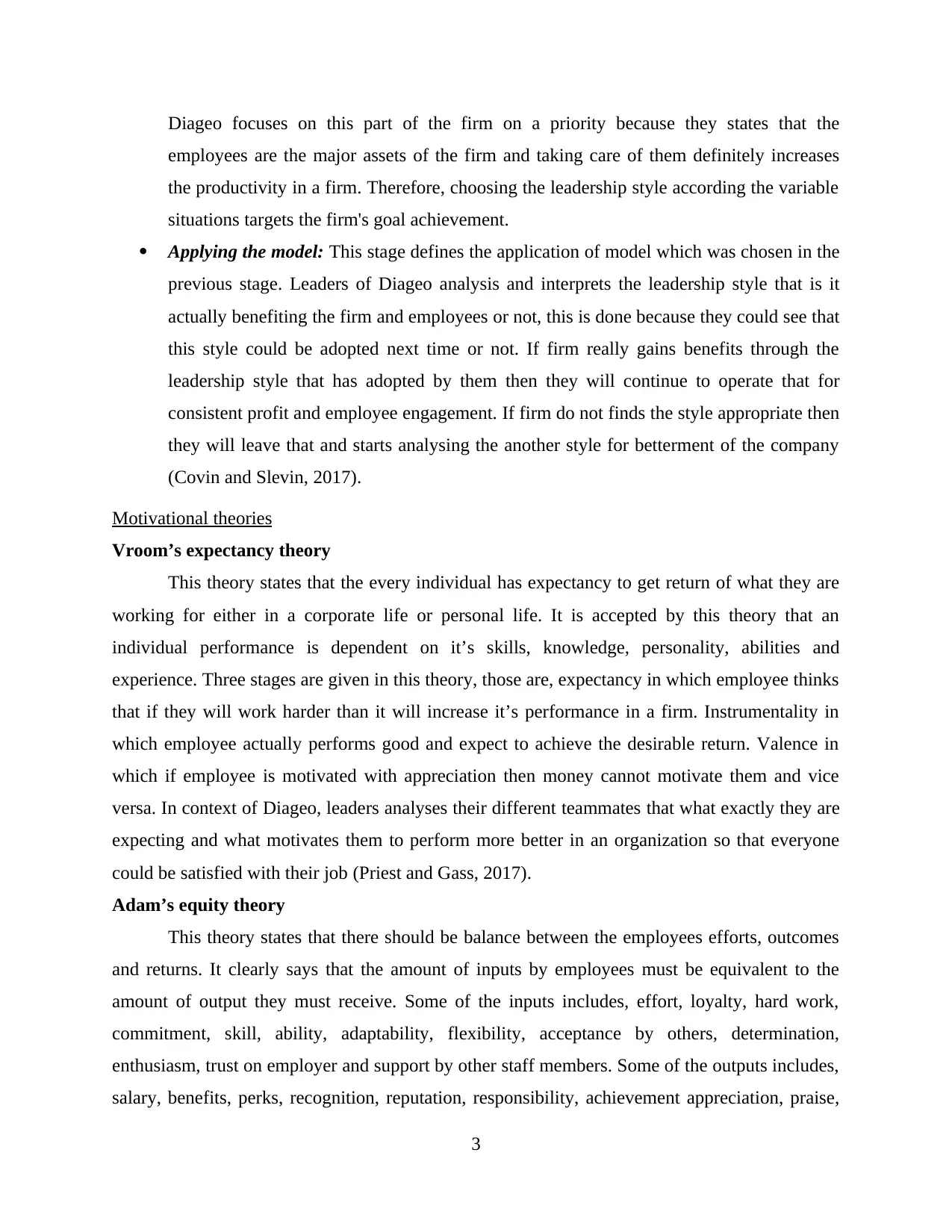
Diageo focuses on this part of the firm on a priority because they states that the
employees are the major assets of the firm and taking care of them definitely increases
the productivity in a firm. Therefore, choosing the leadership style according the variable
situations targets the firm's goal achievement.
Applying the model: This stage defines the application of model which was chosen in the
previous stage. Leaders of Diageo analysis and interprets the leadership style that is it
actually benefiting the firm and employees or not, this is done because they could see that
this style could be adopted next time or not. If firm really gains benefits through the
leadership style that has adopted by them then they will continue to operate that for
consistent profit and employee engagement. If firm do not finds the style appropriate then
they will leave that and starts analysing the another style for betterment of the company
(Covin and Slevin, 2017).
Motivational theories
Vroom’s expectancy theory
This theory states that the every individual has expectancy to get return of what they are
working for either in a corporate life or personal life. It is accepted by this theory that an
individual performance is dependent on it’s skills, knowledge, personality, abilities and
experience. Three stages are given in this theory, those are, expectancy in which employee thinks
that if they will work harder than it will increase it’s performance in a firm. Instrumentality in
which employee actually performs good and expect to achieve the desirable return. Valence in
which if employee is motivated with appreciation then money cannot motivate them and vice
versa. In context of Diageo, leaders analyses their different teammates that what exactly they are
expecting and what motivates them to perform more better in an organization so that everyone
could be satisfied with their job (Priest and Gass, 2017).
Adam’s equity theory
This theory states that there should be balance between the employees efforts, outcomes
and returns. It clearly says that the amount of inputs by employees must be equivalent to the
amount of output they must receive. Some of the inputs includes, effort, loyalty, hard work,
commitment, skill, ability, adaptability, flexibility, acceptance by others, determination,
enthusiasm, trust on employer and support by other staff members. Some of the outputs includes,
salary, benefits, perks, recognition, reputation, responsibility, achievement appreciation, praise,
3
employees are the major assets of the firm and taking care of them definitely increases
the productivity in a firm. Therefore, choosing the leadership style according the variable
situations targets the firm's goal achievement.
Applying the model: This stage defines the application of model which was chosen in the
previous stage. Leaders of Diageo analysis and interprets the leadership style that is it
actually benefiting the firm and employees or not, this is done because they could see that
this style could be adopted next time or not. If firm really gains benefits through the
leadership style that has adopted by them then they will continue to operate that for
consistent profit and employee engagement. If firm do not finds the style appropriate then
they will leave that and starts analysing the another style for betterment of the company
(Covin and Slevin, 2017).
Motivational theories
Vroom’s expectancy theory
This theory states that the every individual has expectancy to get return of what they are
working for either in a corporate life or personal life. It is accepted by this theory that an
individual performance is dependent on it’s skills, knowledge, personality, abilities and
experience. Three stages are given in this theory, those are, expectancy in which employee thinks
that if they will work harder than it will increase it’s performance in a firm. Instrumentality in
which employee actually performs good and expect to achieve the desirable return. Valence in
which if employee is motivated with appreciation then money cannot motivate them and vice
versa. In context of Diageo, leaders analyses their different teammates that what exactly they are
expecting and what motivates them to perform more better in an organization so that everyone
could be satisfied with their job (Priest and Gass, 2017).
Adam’s equity theory
This theory states that there should be balance between the employees efforts, outcomes
and returns. It clearly says that the amount of inputs by employees must be equivalent to the
amount of output they must receive. Some of the inputs includes, effort, loyalty, hard work,
commitment, skill, ability, adaptability, flexibility, acceptance by others, determination,
enthusiasm, trust on employer and support by other staff members. Some of the outputs includes,
salary, benefits, perks, recognition, reputation, responsibility, achievement appreciation, praise,
3
⊘ This is a preview!⊘
Do you want full access?
Subscribe today to unlock all pages.

Trusted by 1+ million students worldwide
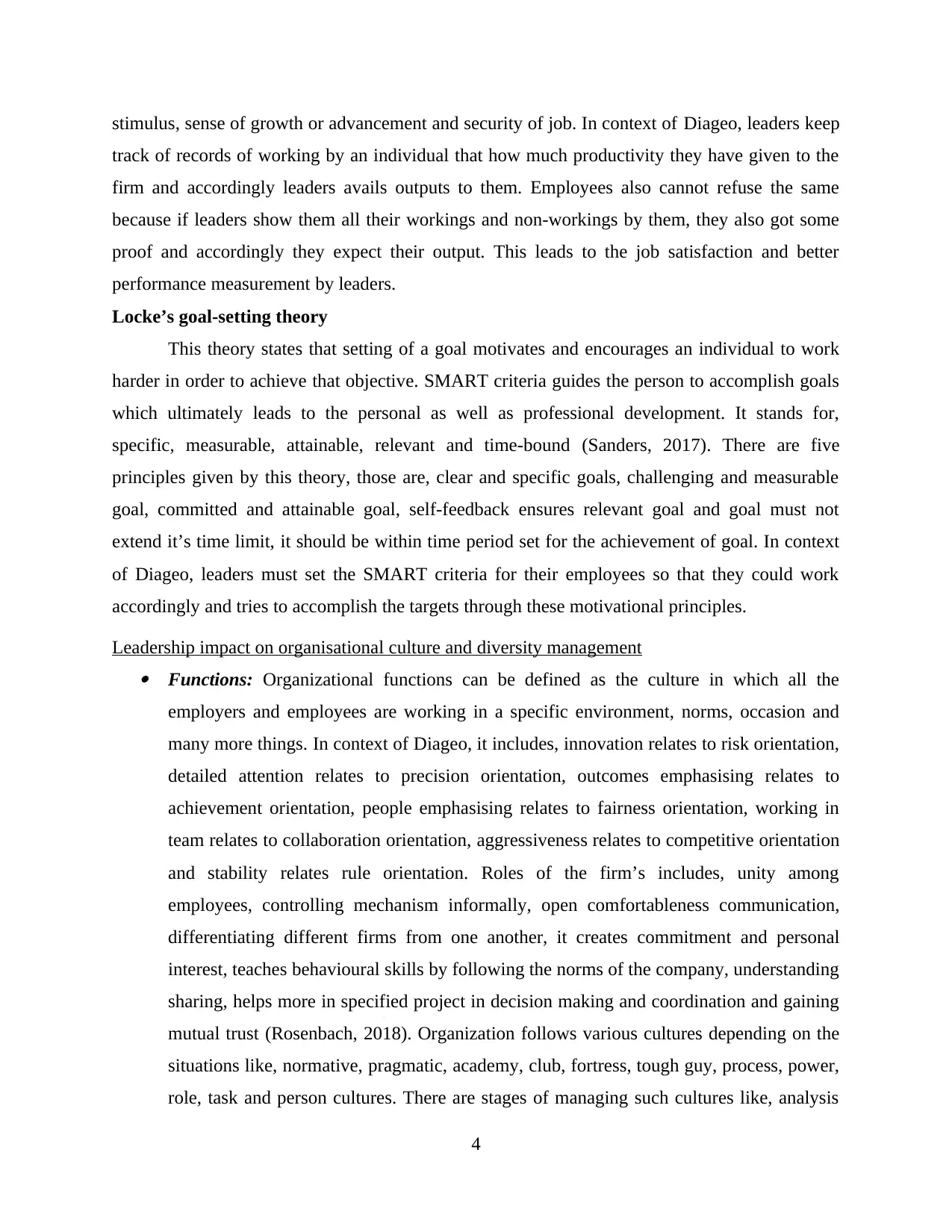
stimulus, sense of growth or advancement and security of job. In context of Diageo, leaders keep
track of records of working by an individual that how much productivity they have given to the
firm and accordingly leaders avails outputs to them. Employees also cannot refuse the same
because if leaders show them all their workings and non-workings by them, they also got some
proof and accordingly they expect their output. This leads to the job satisfaction and better
performance measurement by leaders.
Locke’s goal-setting theory
This theory states that setting of a goal motivates and encourages an individual to work
harder in order to achieve that objective. SMART criteria guides the person to accomplish goals
which ultimately leads to the personal as well as professional development. It stands for,
specific, measurable, attainable, relevant and time-bound (Sanders, 2017). There are five
principles given by this theory, those are, clear and specific goals, challenging and measurable
goal, committed and attainable goal, self-feedback ensures relevant goal and goal must not
extend it’s time limit, it should be within time period set for the achievement of goal. In context
of Diageo, leaders must set the SMART criteria for their employees so that they could work
accordingly and tries to accomplish the targets through these motivational principles.
Leadership impact on organisational culture and diversity management Functions: Organizational functions can be defined as the culture in which all the
employers and employees are working in a specific environment, norms, occasion and
many more things. In context of Diageo, it includes, innovation relates to risk orientation,
detailed attention relates to precision orientation, outcomes emphasising relates to
achievement orientation, people emphasising relates to fairness orientation, working in
team relates to collaboration orientation, aggressiveness relates to competitive orientation
and stability relates rule orientation. Roles of the firm’s includes, unity among
employees, controlling mechanism informally, open comfortableness communication,
differentiating different firms from one another, it creates commitment and personal
interest, teaches behavioural skills by following the norms of the company, understanding
sharing, helps more in specified project in decision making and coordination and gaining
mutual trust (Rosenbach, 2018). Organization follows various cultures depending on the
situations like, normative, pragmatic, academy, club, fortress, tough guy, process, power,
role, task and person cultures. There are stages of managing such cultures like, analysis
4
track of records of working by an individual that how much productivity they have given to the
firm and accordingly leaders avails outputs to them. Employees also cannot refuse the same
because if leaders show them all their workings and non-workings by them, they also got some
proof and accordingly they expect their output. This leads to the job satisfaction and better
performance measurement by leaders.
Locke’s goal-setting theory
This theory states that setting of a goal motivates and encourages an individual to work
harder in order to achieve that objective. SMART criteria guides the person to accomplish goals
which ultimately leads to the personal as well as professional development. It stands for,
specific, measurable, attainable, relevant and time-bound (Sanders, 2017). There are five
principles given by this theory, those are, clear and specific goals, challenging and measurable
goal, committed and attainable goal, self-feedback ensures relevant goal and goal must not
extend it’s time limit, it should be within time period set for the achievement of goal. In context
of Diageo, leaders must set the SMART criteria for their employees so that they could work
accordingly and tries to accomplish the targets through these motivational principles.
Leadership impact on organisational culture and diversity management Functions: Organizational functions can be defined as the culture in which all the
employers and employees are working in a specific environment, norms, occasion and
many more things. In context of Diageo, it includes, innovation relates to risk orientation,
detailed attention relates to precision orientation, outcomes emphasising relates to
achievement orientation, people emphasising relates to fairness orientation, working in
team relates to collaboration orientation, aggressiveness relates to competitive orientation
and stability relates rule orientation. Roles of the firm’s includes, unity among
employees, controlling mechanism informally, open comfortableness communication,
differentiating different firms from one another, it creates commitment and personal
interest, teaches behavioural skills by following the norms of the company, understanding
sharing, helps more in specified project in decision making and coordination and gaining
mutual trust (Rosenbach, 2018). Organization follows various cultures depending on the
situations like, normative, pragmatic, academy, club, fortress, tough guy, process, power,
role, task and person cultures. There are stages of managing such cultures like, analysis
4
Paraphrase This Document
Need a fresh take? Get an instant paraphrase of this document with our AI Paraphraser
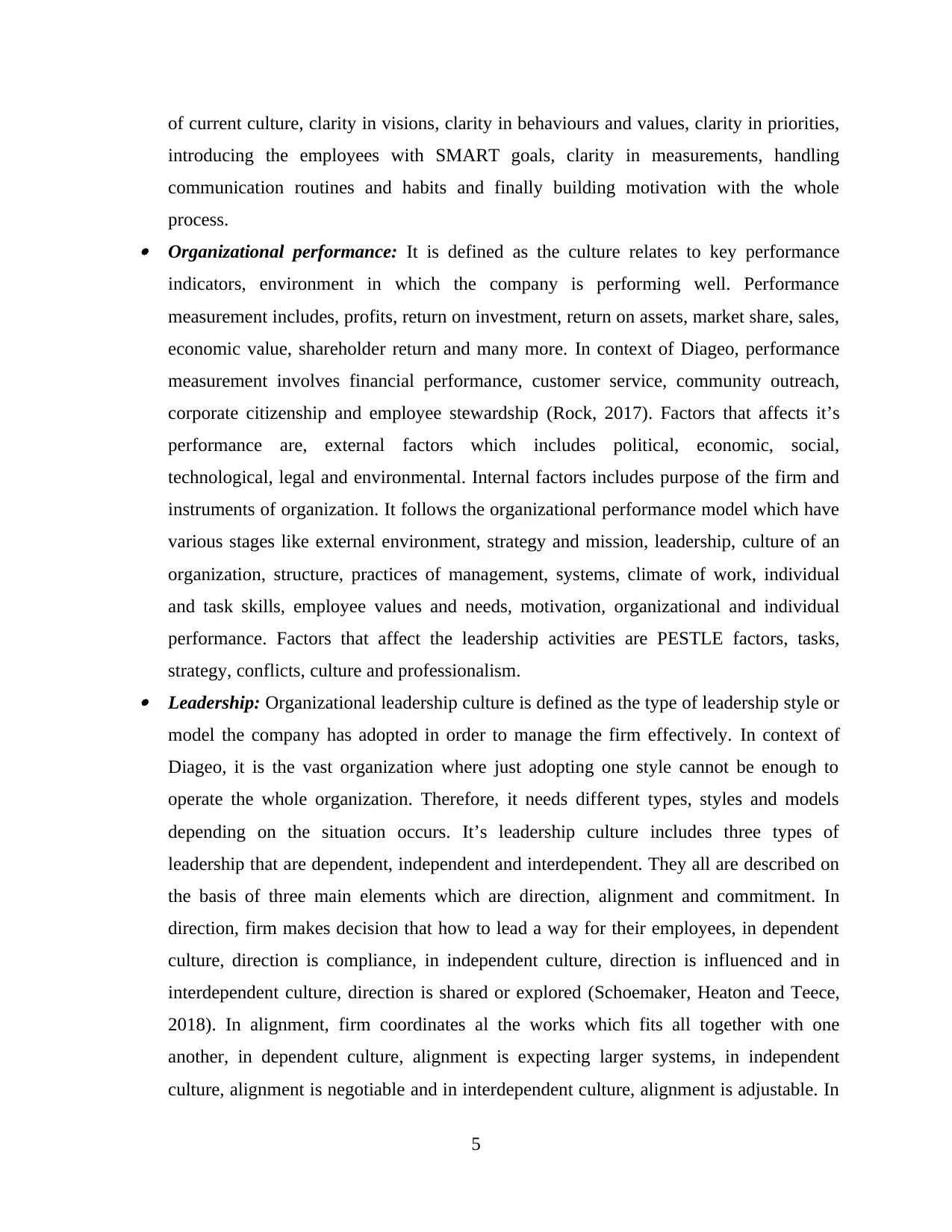
of current culture, clarity in visions, clarity in behaviours and values, clarity in priorities,
introducing the employees with SMART goals, clarity in measurements, handling
communication routines and habits and finally building motivation with the whole
process. Organizational performance: It is defined as the culture relates to key performance
indicators, environment in which the company is performing well. Performance
measurement includes, profits, return on investment, return on assets, market share, sales,
economic value, shareholder return and many more. In context of Diageo, performance
measurement involves financial performance, customer service, community outreach,
corporate citizenship and employee stewardship (Rock, 2017). Factors that affects it’s
performance are, external factors which includes political, economic, social,
technological, legal and environmental. Internal factors includes purpose of the firm and
instruments of organization. It follows the organizational performance model which have
various stages like external environment, strategy and mission, leadership, culture of an
organization, structure, practices of management, systems, climate of work, individual
and task skills, employee values and needs, motivation, organizational and individual
performance. Factors that affect the leadership activities are PESTLE factors, tasks,
strategy, conflicts, culture and professionalism. Leadership: Organizational leadership culture is defined as the type of leadership style or
model the company has adopted in order to manage the firm effectively. In context of
Diageo, it is the vast organization where just adopting one style cannot be enough to
operate the whole organization. Therefore, it needs different types, styles and models
depending on the situation occurs. It’s leadership culture includes three types of
leadership that are dependent, independent and interdependent. They all are described on
the basis of three main elements which are direction, alignment and commitment. In
direction, firm makes decision that how to lead a way for their employees, in dependent
culture, direction is compliance, in independent culture, direction is influenced and in
interdependent culture, direction is shared or explored (Schoemaker, Heaton and Teece,
2018). In alignment, firm coordinates al the works which fits all together with one
another, in dependent culture, alignment is expecting larger systems, in independent
culture, alignment is negotiable and in interdependent culture, alignment is adjustable. In
5
introducing the employees with SMART goals, clarity in measurements, handling
communication routines and habits and finally building motivation with the whole
process. Organizational performance: It is defined as the culture relates to key performance
indicators, environment in which the company is performing well. Performance
measurement includes, profits, return on investment, return on assets, market share, sales,
economic value, shareholder return and many more. In context of Diageo, performance
measurement involves financial performance, customer service, community outreach,
corporate citizenship and employee stewardship (Rock, 2017). Factors that affects it’s
performance are, external factors which includes political, economic, social,
technological, legal and environmental. Internal factors includes purpose of the firm and
instruments of organization. It follows the organizational performance model which have
various stages like external environment, strategy and mission, leadership, culture of an
organization, structure, practices of management, systems, climate of work, individual
and task skills, employee values and needs, motivation, organizational and individual
performance. Factors that affect the leadership activities are PESTLE factors, tasks,
strategy, conflicts, culture and professionalism. Leadership: Organizational leadership culture is defined as the type of leadership style or
model the company has adopted in order to manage the firm effectively. In context of
Diageo, it is the vast organization where just adopting one style cannot be enough to
operate the whole organization. Therefore, it needs different types, styles and models
depending on the situation occurs. It’s leadership culture includes three types of
leadership that are dependent, independent and interdependent. They all are described on
the basis of three main elements which are direction, alignment and commitment. In
direction, firm makes decision that how to lead a way for their employees, in dependent
culture, direction is compliance, in independent culture, direction is influenced and in
interdependent culture, direction is shared or explored (Schoemaker, Heaton and Teece,
2018). In alignment, firm coordinates al the works which fits all together with one
another, in dependent culture, alignment is expecting larger systems, in independent
culture, alignment is negotiable and in interdependent culture, alignment is adjustable. In
5
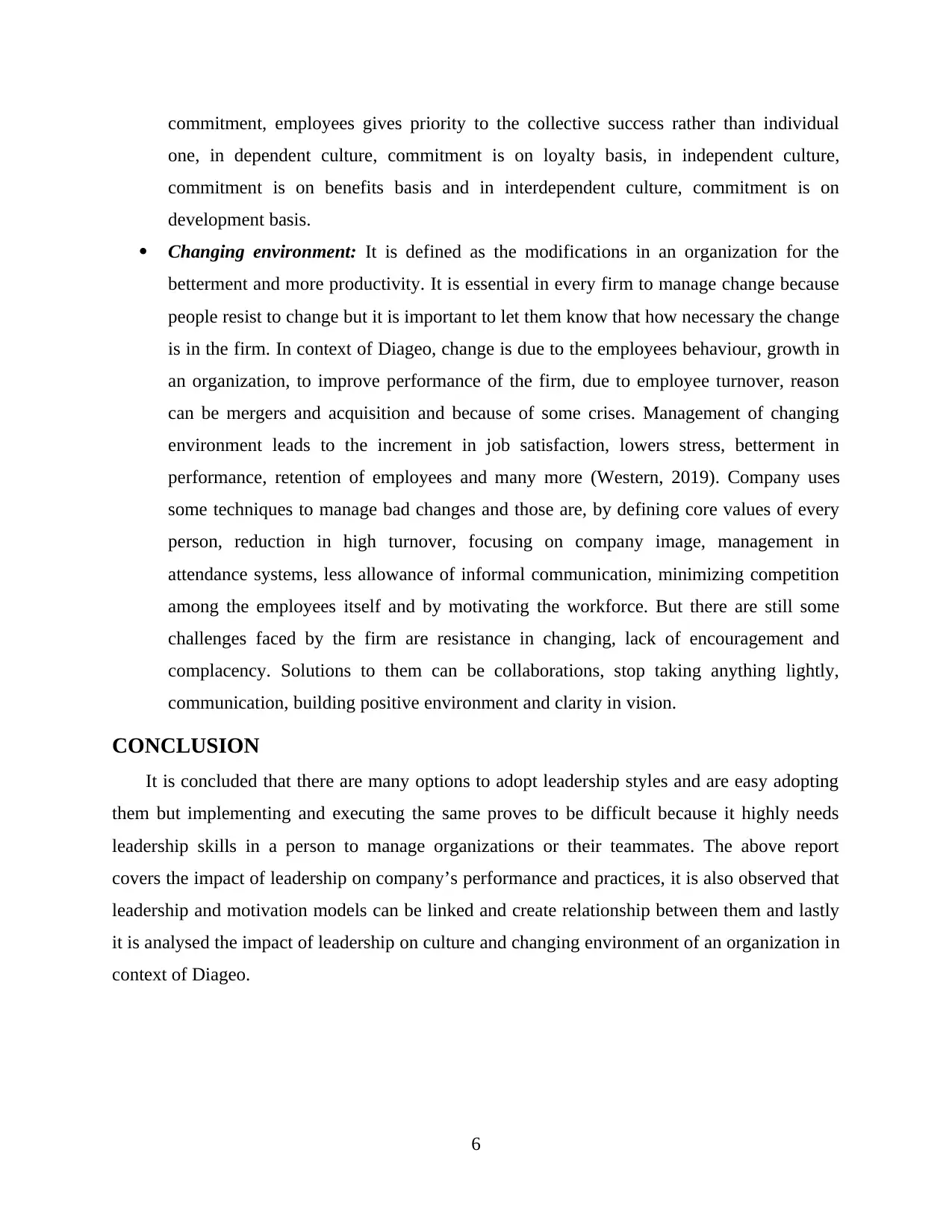
commitment, employees gives priority to the collective success rather than individual
one, in dependent culture, commitment is on loyalty basis, in independent culture,
commitment is on benefits basis and in interdependent culture, commitment is on
development basis.
Changing environment: It is defined as the modifications in an organization for the
betterment and more productivity. It is essential in every firm to manage change because
people resist to change but it is important to let them know that how necessary the change
is in the firm. In context of Diageo, change is due to the employees behaviour, growth in
an organization, to improve performance of the firm, due to employee turnover, reason
can be mergers and acquisition and because of some crises. Management of changing
environment leads to the increment in job satisfaction, lowers stress, betterment in
performance, retention of employees and many more (Western, 2019). Company uses
some techniques to manage bad changes and those are, by defining core values of every
person, reduction in high turnover, focusing on company image, management in
attendance systems, less allowance of informal communication, minimizing competition
among the employees itself and by motivating the workforce. But there are still some
challenges faced by the firm are resistance in changing, lack of encouragement and
complacency. Solutions to them can be collaborations, stop taking anything lightly,
communication, building positive environment and clarity in vision.
CONCLUSION
It is concluded that there are many options to adopt leadership styles and are easy adopting
them but implementing and executing the same proves to be difficult because it highly needs
leadership skills in a person to manage organizations or their teammates. The above report
covers the impact of leadership on company’s performance and practices, it is also observed that
leadership and motivation models can be linked and create relationship between them and lastly
it is analysed the impact of leadership on culture and changing environment of an organization in
context of Diageo.
6
one, in dependent culture, commitment is on loyalty basis, in independent culture,
commitment is on benefits basis and in interdependent culture, commitment is on
development basis.
Changing environment: It is defined as the modifications in an organization for the
betterment and more productivity. It is essential in every firm to manage change because
people resist to change but it is important to let them know that how necessary the change
is in the firm. In context of Diageo, change is due to the employees behaviour, growth in
an organization, to improve performance of the firm, due to employee turnover, reason
can be mergers and acquisition and because of some crises. Management of changing
environment leads to the increment in job satisfaction, lowers stress, betterment in
performance, retention of employees and many more (Western, 2019). Company uses
some techniques to manage bad changes and those are, by defining core values of every
person, reduction in high turnover, focusing on company image, management in
attendance systems, less allowance of informal communication, minimizing competition
among the employees itself and by motivating the workforce. But there are still some
challenges faced by the firm are resistance in changing, lack of encouragement and
complacency. Solutions to them can be collaborations, stop taking anything lightly,
communication, building positive environment and clarity in vision.
CONCLUSION
It is concluded that there are many options to adopt leadership styles and are easy adopting
them but implementing and executing the same proves to be difficult because it highly needs
leadership skills in a person to manage organizations or their teammates. The above report
covers the impact of leadership on company’s performance and practices, it is also observed that
leadership and motivation models can be linked and create relationship between them and lastly
it is analysed the impact of leadership on culture and changing environment of an organization in
context of Diageo.
6
⊘ This is a preview!⊘
Do you want full access?
Subscribe today to unlock all pages.

Trusted by 1+ million students worldwide
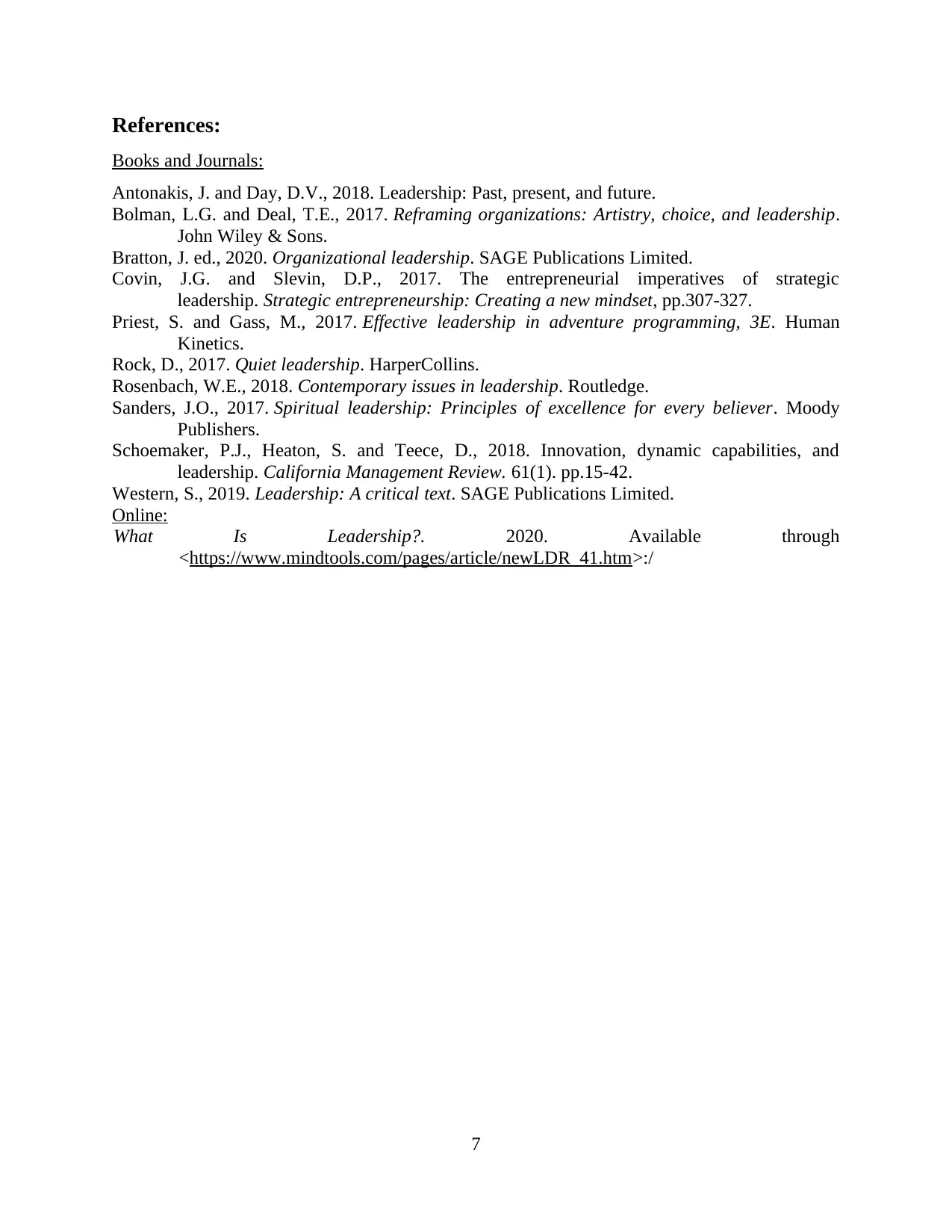
References:
Books and Journals:
Antonakis, J. and Day, D.V., 2018. Leadership: Past, present, and future.
Bolman, L.G. and Deal, T.E., 2017. Reframing organizations: Artistry, choice, and leadership.
John Wiley & Sons.
Bratton, J. ed., 2020. Organizational leadership. SAGE Publications Limited.
Covin, J.G. and Slevin, D.P., 2017. The entrepreneurial imperatives of strategic
leadership. Strategic entrepreneurship: Creating a new mindset, pp.307-327.
Priest, S. and Gass, M., 2017. Effective leadership in adventure programming, 3E. Human
Kinetics.
Rock, D., 2017. Quiet leadership. HarperCollins.
Rosenbach, W.E., 2018. Contemporary issues in leadership. Routledge.
Sanders, J.O., 2017. Spiritual leadership: Principles of excellence for every believer. Moody
Publishers.
Schoemaker, P.J., Heaton, S. and Teece, D., 2018. Innovation, dynamic capabilities, and
leadership. California Management Review. 61(1). pp.15-42.
Western, S., 2019. Leadership: A critical text. SAGE Publications Limited.
Online:
What Is Leadership?. 2020. Available through
<https://www.mindtools.com/pages/article/newLDR_41.htm>:/
7
Books and Journals:
Antonakis, J. and Day, D.V., 2018. Leadership: Past, present, and future.
Bolman, L.G. and Deal, T.E., 2017. Reframing organizations: Artistry, choice, and leadership.
John Wiley & Sons.
Bratton, J. ed., 2020. Organizational leadership. SAGE Publications Limited.
Covin, J.G. and Slevin, D.P., 2017. The entrepreneurial imperatives of strategic
leadership. Strategic entrepreneurship: Creating a new mindset, pp.307-327.
Priest, S. and Gass, M., 2017. Effective leadership in adventure programming, 3E. Human
Kinetics.
Rock, D., 2017. Quiet leadership. HarperCollins.
Rosenbach, W.E., 2018. Contemporary issues in leadership. Routledge.
Sanders, J.O., 2017. Spiritual leadership: Principles of excellence for every believer. Moody
Publishers.
Schoemaker, P.J., Heaton, S. and Teece, D., 2018. Innovation, dynamic capabilities, and
leadership. California Management Review. 61(1). pp.15-42.
Western, S., 2019. Leadership: A critical text. SAGE Publications Limited.
Online:
What Is Leadership?. 2020. Available through
<https://www.mindtools.com/pages/article/newLDR_41.htm>:/
7
1 out of 10
Related Documents
Your All-in-One AI-Powered Toolkit for Academic Success.
+13062052269
info@desklib.com
Available 24*7 on WhatsApp / Email
![[object Object]](/_next/static/media/star-bottom.7253800d.svg)
Unlock your academic potential
Copyright © 2020–2025 A2Z Services. All Rights Reserved. Developed and managed by ZUCOL.





